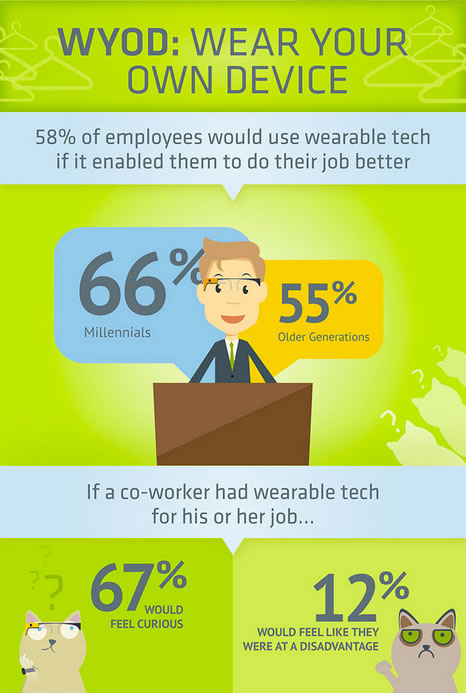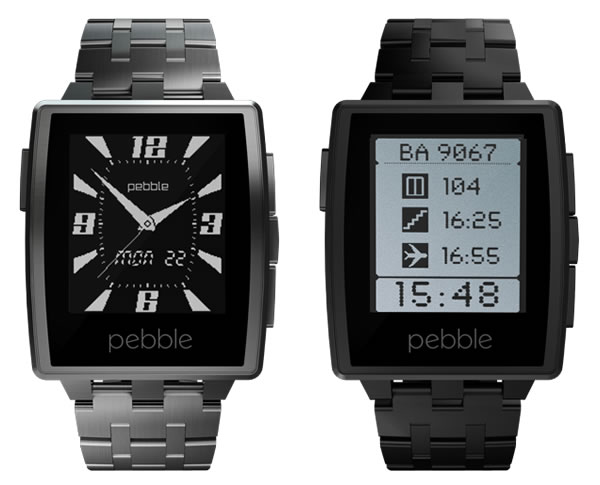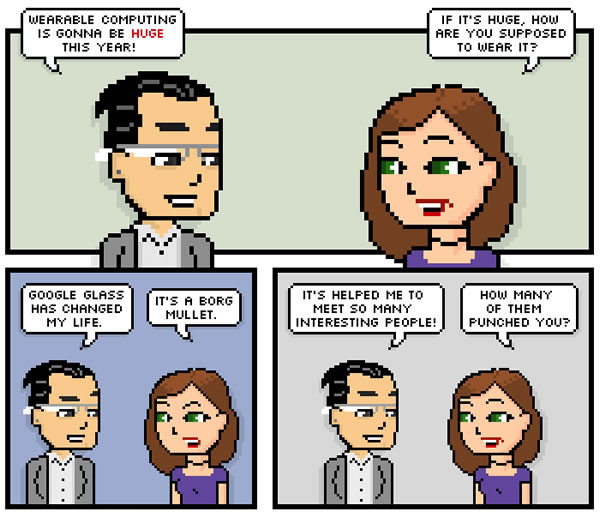How employees feel about wearables
The “wearables” section of Cornerstone on Demand’s State of Workplace Productivity infographic.
Click it to see the source.
Wearables are still a way off from mainstream use at the workplace, but once upon a time, so were desktop and laptop computers, and so were smartphones and tablets. The section on wearables in Cornerstone OnDemand’s State of Workplace Productivity 2013 Report caught our eye, and we thought we’d share it with you here.
The report has a lot of figures on mobile devices at work and BYOD, so we’ll very likely cite it in upcoming articles.
Pebble Steel
Pebble Steel’s brushed stainless steel (left) and black matte (right) models.
Click the photo to visit Pebble’s site.
Pebble — the small smartwatch company launched out of a living room in Palo Alto — have released their new Pebble Steel watch, and unlike others on the market, it looks as if it were actually made for grown-ups. Engadget has posted a review, which they close with:
Simply put, the Steel isn’t going to persuade many people to swap out their perfectly functional Hamilton, Movado or Citizen, but if you’re in the market for a replacement and want a smartwatch, this is your best option. What’s most important, though, is what the Steel represents: a realization that if smartwatches are going to become mainstream, they’ll need to appeal to people who prefer to adorn their wrists with jewelry. At the very least, the Steel is a significant step in the right direction.
Google’s contact lens for diabetes patients, and Microsoft Research’s version from 2011
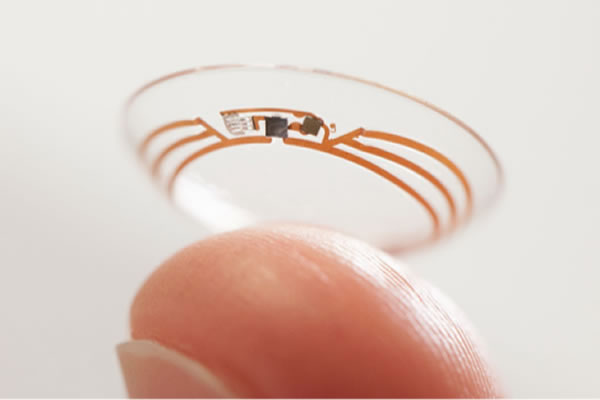
Google’s blood sugar-sensing contact lens.
Click the photo to read the article on Re/Code.
The 400 million people worldwide with diabetes have a metabolic condition where they have high blood sugar either because they’re not producing enough insulin or because their cells don’t respond adequately to it. They manage their diabetes by checking their blood sugar levels several times a day, a process that usually involves some form of being poked with a needle.
Google’s latest announced research project is a contact lens that measures the glucose content of its wearer’s tears, which is a function of that person’s blood sugar level. The lens functions as a circuit board that houses the components and a circular gold foil antenna that lies outside the pupil’s visual range. Google says that their research wing, Google X, is working on the project not so they can eventually build and sell diabetes-monitoring contact lenses, but to publicize the work in order to find medical company partners to develop them.
As TechCrunch notes, Google’s not the first tech company to build such a prototype. Microsoft Research released this video that makes mention of a similar project back in 2011:
It turns out that a member of Microsoft Research who was working on their smart contact lens project, Babak Parviz (a former engineering professor at University of Washington), is now at Google, where he works on Google Glass and the smart contact lens project. Once upon a time, the brain drain worked in the other direction, with Microsoft absorbing bright lights from other companies, including Anders Heljberg from Borland, who ended up revitalizing their programming tools and creating the C# programming language (which in my opinion, is an improvement on Java).
California tech entrepreneur beats “driving while glassing” ticket
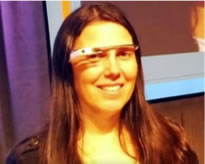 Cecilia Abadie made history last year as the first driver to be given a traffic ticket for driving while using Google Glass, based on the California traffic law that states that you can’t drive while watching a monitor. She was initially pulled over for speeding on Interstate 15, but when the officer saw that she was wearing Google Glass, she was issued a second ticket for “driving while glassing”.
Cecilia Abadie made history last year as the first driver to be given a traffic ticket for driving while using Google Glass, based on the California traffic law that states that you can’t drive while watching a monitor. She was initially pulled over for speeding on Interstate 15, but when the officer saw that she was wearing Google Glass, she was issued a second ticket for “driving while glassing”.
Both the speeding and “driving while using a visual monitor” charge were dropped by San Diego Court Commissioner John Blair for lack of evidence. The police office who ticketed Abadie matched her speed with his car, and an expert did not show up at court to testify to the calibration of his speedometer. Abadie also testified that her Google Glass was off when she was driving, and there was also no proof that the Glass was turned off at the time.
My guess is that a whole host of legal and social problems could be solved by building some kind of indicator into Google Glass and similar wearables that indicates to other people that it’s on, perhaps something like the light that comes on when the webcam on your laptop or desktop is active.
Chinese pirates see no upside in making knock-offs of wearables

Click the photo to see the cringeworthy ad it came from.
While working on a story where they went to China to learn how the tech “knock-off” industry works, CNN reports that tech counterfeiters, who only copy devices that will help them make a profit, are quite obviously not making copies of wearable mobile devices.
They note that at Shenzhen’s Huaqiangbei (pronounced “Wa-chang-bay”) commercial district, the place to go for original and copycat electronics and components, demand for Samsung’s Galaxy Gear smartwatch is “ice-cold”:
“You won’t find any copies of the smart watch here. I’ve never seen or heard of any,” said a young man who was busy shipping off boxes, that he said were filled with counterfeit mobile phones, at a local logistics center.
“Thinking about it, I’ve never even seen anyone wear one,” he added.
If you’re curious about Huaqiangbei, here’s an interesting video published in February 2013, where Bob Jordan from AsianOps takes a tour of the electronics mall:
Diesel Sweeties’ amusing take on wearables
R. Stevens’ geek-and-hipster-centric webcomic Diesel Sweeties has an interesting term for Google Glass:
Click to see the full comic.
“Borg mullet.” Heh.
